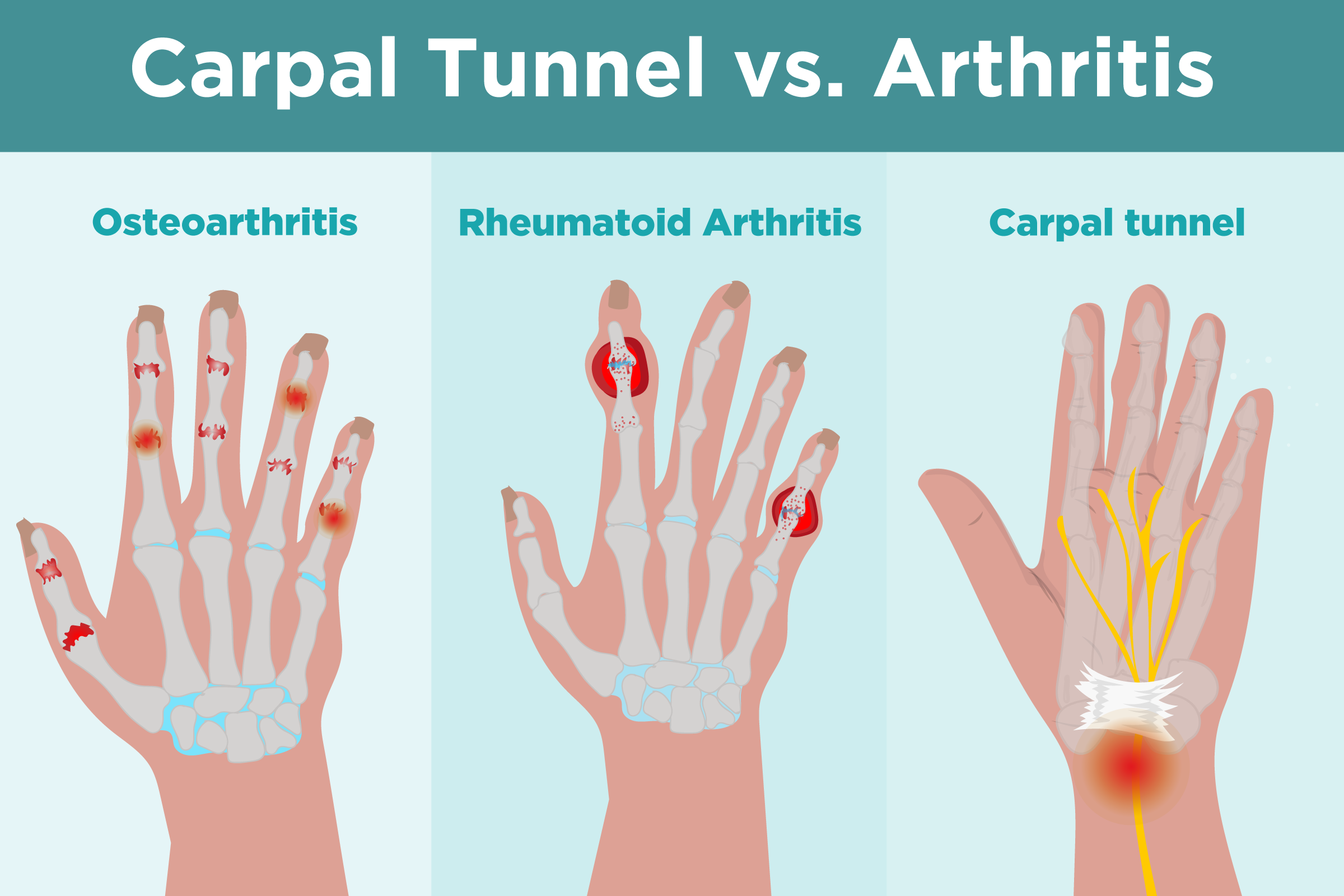Carpal Tunnel Syndrome
Carpal tunnel syndrome is a common condition that causes pain, numbness, tingling, and weakness in the hand and wrist. It happens when there is increased pressure within the wrist on a nerve called the median nerve. This nerve provides sensation to the thumb, index, and middle fingers, and to half of the ring finger. The small finger (the “pinky”) is typically not affected.
At Aptiva Health, we offer immediate appointments for carpal tunnel syndrome to evaluate, diagnose, and make the appropriate referral for additional treatment based upon your specific diagnosis. We treat carpal tunnel syndrome in our General Medicine, Orthopedics, Sports Medicine, Pain Management, and Physical Therapy departments.
Cause, Types, and Symptoms
Carpal tunnel syndrome is caused when the space (the carpal tunnel) in the wrist narrows. This presses down on the median nerve and tendons (located inside the carpal tunnel), makes them swell, which cuts off sensation in the fingers and hand.
While carpal tunnel syndrome is a common condition, it has a different set of symptoms from many other sources of hand pain. There are actually several similar conditions that cause hand pain. These include:
De Quervain’s tenosynovitis: A condition where swelling (inflammation) affects the wrist and base of the thumb. In this condition, you will feel pain when you make a fist and simulate shaking someone’s hand.
Trigger finger: This condition causes soreness at the base of the finger or thumb. Trigger finger also causes pain, locking (or catching) and stiffness when bending the fingers and thumb.
Arthritis: This is a general term for many conditions that cause stiffness and swelling in your joints. Arthritis can impact many joints in your body and ranges from causing small amounts of discomfort to breaking down the joint over time (osteoarthritis is one type of degenerative arthritis).
Symptoms usually begin slowly and can occur at any time. Early symptoms include:
Numbness at night.
Tingling and/or pain in the fingers (especially the thumb, index and middle fingers).
In fact, because some people sleep with their wrists curled, nighttime symptoms are common and can wake people from sleep. These nighttime symptoms are often the first reported symptoms. Shaking the hands helps relieve symptoms in the early stage of the condition.
Common daytime symptoms can include:
Tingling in the fingers.
Decreased feeling in the fingertips.
Difficulty using the hand for small tasks, like:
Handling small objects.
Grasping a steering wheel to drive.
Holding a book to read.
Writing.
Using a computer keyboard.
As carpal tunnel syndrome worsens, symptoms become more constant. These symptoms can include:
Weakness in the hand.
Inability to perform tasks that require delicate motions (such as buttoning a shirt).
Dropping objects.
In the most severe condition, the muscles at the base of the thumb visibly shrink in size (atrophy).
Diagnosis & Treatment Options
First, your doctor will discuss your symptoms, medical history and examine you. Next, tests are performed, which may include:
Tinel’s sign: In this test, the physician taps over the median nerve at the wrist to see if it produces a tingling sensation in the fingers.
Wrist flexion test (or Phalen test): In this test, the patient rests his or her elbows on a table and allows the wrist to fall forward freely. Individuals with carpal tunnel syndrome will experience numbness and tingling in the fingers within 60 seconds. The more quickly symptoms appear, the more severe the carpal tunnel syndrome.
X-rays: X-rays of the wrist may be ordered if there is limited wrist motion, or evidence of arthritis or trauma.
Electromyography (EMG) and nerve conduction studies: These studies determine how well the median nerve itself is working and how well it controls muscle movement.
Carpal tunnel syndrome can be treated in two ways: non-surgically or with surgery. There are pros and cons to both approaches. Typically, non-surgical treatments are used for less severe cases and allow you to continue with daily activities without interruption. Surgical treatments can help in more severe cases and have very positive outcomes.
Non-surgical treatments
Non-Surgical Treatment Options:
Wearing a wrist splint at night.
Taking nonsteroidal anti-inflammatory drugs, such as ibuprofen.
Cortisone injections.
Other treatments focus on ways to change your environment to decrease symptoms. This is often seen in the workplace, where you can make modifications to help with carpal tunnel.
These changes might include:
Raising or lowering your chair.
Moving your computer keyboard.
Changing your hand/wrist position while doing activities.
Using recommended splints, exercises and heat treatments from a hand therapist.
Surgical treatments
Surgery is recommended when carpal tunnel syndrome does not respond to non-surgical treatments or has already become severe. The goal of surgery is to increase the size of the tunnel in order to decrease the pressure on the nerves and tendons that pass through the space. This is done by cutting (releasing) the ligament that covers the carpal tunnel at the base of the palm. This ligament is called the transverse carpal ligament.
If you have surgery, you can expect to:
Have an outpatient procedure where you will be awake, but have local anesthesia (pain numbing medication). In some cases, your doctor may offer an IV (directly into the vein) anesthetic. This option allows you to take a brief nap and wake up after the procedure is finished. This is not a general anesthetic, like what is used in surgery. Instead, your healthcare team will monitor you during the procedure (called monitored anesthetic care, or MAC). This is also used for procedures like a colonoscopy.
Be in brief discomfort for about 24 to 72 hours after surgery. People usually experience complete nighttime symptom relief quickly—even the night after surgery.
Have your stitches removed 10 to 14 days after surgery. Hand and wrist use for everyday activities is gradually restored by using specific exercise programs.
Be unable to do heavier activities with the affected hand for about four to six weeks. Recovery times can vary depending on your age, general health, severity of carpal tunnel syndrome and how long you had symptoms. You will continue to gain strength and sensation in the following year after surgery.
Have relief from most carpal tunnel syndrome symptoms.









